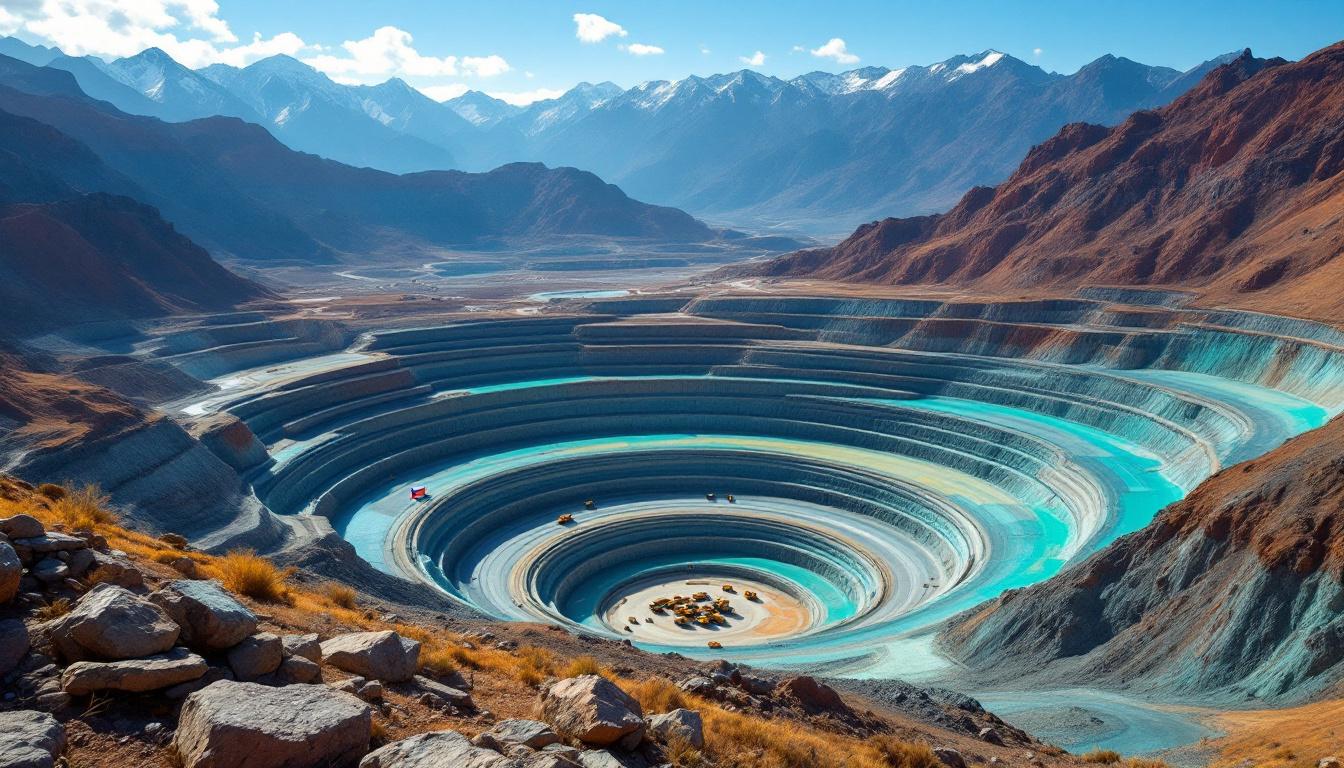Norway's Wealth Fund Takes Active Stance on Environmental Issues with Mining Giants
Norway's sovereign wealth fund, one of the world's largest with assets exceeding $1.6 trillion, has opted for an engagement strategy with mining companies Rio Tinto and South32 rather than divesting, despite serious environmental concerns in the Amazon rainforest. This approach signals a maturing perspective on environmental stewardship that could influence investment practices worldwide.
The Amazon Rainforest Mining Operations Under Scrutiny
The Mineração Rio do Norte (MRN) joint venture, a significant bauxite mining operation in Brazil's Amazon rainforest, has drawn heightened attention from Norway's fund managers. This operation triggered such substantial environmental concerns that Norway's Council on Ethics formally recommended divestment from companies involved in the venture.
MRN's operations involve extensive land clearing, open-pit excavation, and infrastructure development in one of the world's most biodiverse regions. According to the Rainforest Foundation Norway, bauxite mining in the Amazon typically requires removing all vegetation and topsoil, creating long-lasting ecological disruption that can extend far beyond the immediate mining area.
"The Amazon rainforest hosts approximately 10% of the world's known biodiversity and plays a crucial role in regional water cycles and climate regulation. Any large-scale industrial operations in this ecosystem require exceptional environmental safeguards," noted a recent RAISG (Amazon Geo-Referenced Socio-Environmental Information Network) assessment.
Ownership Structure of the Problematic Joint Venture
The MRN joint venture that triggered Norway's scrutiny involves three major mining companies with clearly defined ownership stakes:
- Glencore: 45% ownership
- South32: 33% ownership
- Rio Tinto: 22% ownership
This ownership structure distributed across multiple major mining corporations complicates accountability for environmental impacts, creating what environmental governance experts call "responsibility diffusion" – where each participant can point to others as responsible parties.
Norway's Fund Significant Holdings in the Companies
Norges Bank Investment Management (NBIM), which manages Norway's sovereign wealth fund, maintains substantial investments in the companies under review:
- 2.5% stake in Rio Tinto plc
- 0.13% stake in Rio Tinto Ltd
- 2.6% stake in South32
These seemingly small percentage holdings translate to billions of dollars in investment value, giving Norway's fund significant leverage as a major shareholder. According to LSEG data, these holdings collectively represent one of the fund's larger resource sector exposures.
How Is Norway's Wealth Fund Addressing These Environmental Concerns?
Rather than simply following the Council on Ethics' recommendation to divest from Rio Tinto and South32, Norway's sovereign wealth fund has chosen a more nuanced approach that reflects the evolving nature of responsible investment practices.
Engagement Strategy Instead of Immediate Divestment
The fund's executive board declined to follow the Ethics Council's recommendation for divestment, instead opting for an active engagement strategy with both companies. This approach aims to leverage the fund's position as a significant shareholder to drive meaningful environmental improvements.
"We believe that active engagement as a shareholder can sometimes be more effective in creating positive change than simply divesting," stated Carine Smith Ihenacho, NBIM's Chief Governance Officer, in a recent statement. "Our goal is to reduce serious environmental damage through our influence as investors."
This stance represents what investment strategists call "voice over exit" – choosing to remain invested while actively pushing for reforms rather than simply selling shares and losing any influence over corporate behavior.
Long-Term Engagement Timeline
The fund has established a structured engagement approach with clearly defined parameters:
- Active engagement period: 5-10 years
- Primary focus: Reducing serious environmental damage
- Strategic goal: Improving environmental practices rather than simply divesting
This lengthy timeframe acknowledges what environmental experts recognize as the reality of meaningful ecological reform – that substantive changes to mining practices and environmental remediation require sustained, long-term commitment rather than quick fixes.
Environmental scientists note that forest recovery in tropical regions like the Amazon can take decades, with full ecological restoration requiring 40+ years under optimal conditions. The fund's 5-10 year engagement timeline aligns with the minimum period needed to implement and assess meaningful ecological improvements.
Contrasting Approaches with Other Companies
The fund's approach to Rio Tinto and South32 differs markedly from its decisions regarding other companies with environmental concerns:
| Company | Industry | Fund's Decision | Rationale |
|---|---|---|---|
| Rio Tinto & South32 | Mining | Engagement | Potential for improvement in Amazon operations |
| RWE AG | Energy | Exclusion revoked | Company's demonstrated shift toward renewable energy |
| Petroleos Mexicanos | Oil & Gas | Divestment | Persistent environmental violations |
| Paz Retail and Energy | Energy | Divestment | Failure to meet environmental standards |
This varied approach demonstrates what investment analysts call "calibrated ESG response" – tailoring actions to specific circumstances rather than applying blanket policies across all companies with environmental concerns.
What Are the Implications of Norway's Wealth Fund Engagement Strategy?
Norway's decision to engage rather than divest carries significant implications for both the mining industry and the broader investment community, potentially reshaping how major investors approach environmental concerns.
Financial Influence as a Tool for Environmental Change
With assets exceeding $1.6 trillion, Norway's sovereign wealth fund wields extraordinary influence in global markets. By choosing engagement over divestment, the fund is strategically deploying this financial power to drive environmental improvements in mining operations.
"Large institutional investors like Norway's fund can achieve more through active ownership than through divestment alone," explained Fiona Reynolds, former CEO of the Principles for Responsible Investment. "When you divest, you lose your seat at the table."
This approach exemplifies what environmental economists term "financial environmentalism" – using market mechanisms and investor pressure to achieve ecological goals rather than relying solely on regulatory approaches.
Setting Standards for Responsible Mining in Sensitive Ecosystems
The fund's engagement with Rio Tinto and South32 establishes clear expectations for responsible mining operations in ecologically sensitive areas like the Amazon rainforest. This creates a framework for evaluating mining activities in biodiversity hotspots worldwide.
The International Council on Mining and Metals (ICMM) has established guidelines for mining in high-conservation-value areas, but implementation remains inconsistent. Norway's engagement approach could strengthen adherence to these standards by demonstrating that major investors take them seriously.
Mining engineering experts note that bauxite extraction can be conducted with significantly reduced environmental impact through techniques like progressive rehabilitation, improved water management, and biodiversity offsetting – but these approaches increase operational costs by 15-30%.
Balancing Investment Returns with Environmental Responsibility
The engagement strategy reflects Norway's attempt to balance financial returns with environmental responsibility. Rather than simply divesting from problematic companies, the fund is working to improve practices while maintaining its investment positions.
Financial analysts estimate that remaining invested while driving environmental improvements can potentially generate superior long-term returns compared to divesting and reinvesting elsewhere. This approach aligns with "universal owner theory," which recognizes that large, diversified investors benefit from improving overall market conditions rather than maximizing short-term returns from individual investments.
How Does This Engagement Fit into Global ESG Investment Trends?
Norway's approach represents a significant evolution in ESG investment practices, potentially influencing how other major investors address environmental concerns in their portfolios.
Evolution of ESG Investment Strategies
The fund's stance represents a maturing approach to Environmental, Social, and Governance (ESG) investment, moving beyond simple exclusion strategies to more sophisticated engagement approaches. This signals an important shift in responsible investment thinking.
According to the Global Sustainable Investment Alliance, global ESG assets under management reached approximately $41 trillion in 2024, with active engagement strategies growing at twice the rate of exclusionary approaches over the past five years.
This transition reflects what investment scholars call "ESG 2.0" – a more nuanced approach focused on creating real-world impact rather than simply avoiding controversial investments.
Influence on Other Sovereign Wealth Funds and Institutional Investors
As a recognized leader among sovereign wealth funds, Norway's engagement strategy may significantly influence how other large institutional investors approach environmental concerns in their portfolios.
A 2024 McKinsey study found that 78% of sovereign wealth funds now prioritize engagement over divestment for ESG issues, up from just 35% in 2019. Norway's detailed approach to Rio Tinto and South32 provides a potential blueprint for others to follow.
The Government Pension Fund Global (GPFG) has previously excluded 156 companies for environmental reasons, creating precedents that other institutional investors often follow. Its shift toward engagement could similarly influence peers.
Creating Accountability Mechanisms for Mining Companies
The fund's engagement creates a robust accountability mechanism for mining companies operating in environmentally sensitive areas. The 5-10 year timeframe establishes clear expectations for demonstrable improvements in environmental practices.
Mining industry observers note that investor pressure has proven more effective than regulatory enforcement in many jurisdictions where environmental governance is weak. The fund's approach could particularly impact operations in regions like the Amazon where regulatory oversight faces significant challenges.
Rio Tinto and South32 will likely need to demonstrate tangible progress through:
- Reduced deforestation rates
- Improved water management practices
- Enhanced biodiversity conservation measures
- Strengthened community relations
What Are the Specific Environmental Challenges in the Amazon Mining Operations?
The MRN joint venture faces several significant environmental challenges that any effective engagement strategy must address.
Biodiversity Impact Concerns
Mining operations in the Amazon rainforest present substantial risks to one of the world's most biodiverse ecosystems. Bauxite mining typically involves:
- Clearing primary forest areas
- Removing all vegetation and topsoil
- Creating open-pit mines
- Building access roads and infrastructure
- Fragmenting previously intact forest ecosystems
These activities directly threaten the Amazon's extraordinary biodiversity. The region hosts approximately 10% of all known species globally, including many found nowhere else on Earth.
Ecological research demonstrates that even small-scale fragmentation can have disproportionate impacts on specialist species, particularly large predators and species dependent on specific ecological niches. Studies show that forest fragments smaller than 1,000 hectares lose up to 50% of their bird species within 15 years.
Water Management and Contamination Risks
Bauxite mining and processing involve significant water management challenges that pose particular risks in the Amazon watershed:
- Water Usage: Processing requires 3.5-7 cubic meters of water per ton of bauxite processed
- Tailings Management: Creates substantial volumes of red mud with high alkalinity
- Sedimentation: Mining increases sediment loads in waterways
- Hydrological Disruption: Alters natural drainage patterns crucial for ecosystem function
The Amazon basin contains approximately 20% of Earth's fresh water, with complex hydrological systems that support both ecological functions and human communities. Mining-related contamination can travel far downstream, affecting areas distant from the original operations.
"Mining disrupts hydrological cycles that are vital not only for biodiversity but also for indigenous livelihoods that have depended on these systems for generations," notes Amazon Watch in their 2024 assessment of extractive industries.
Indigenous Communities and Social License
Mining operations in the Amazon frequently overlap with territories important to indigenous communities, raising critical questions about consent, consultation, and impact mitigation.
Brazil's Indigenous Peoples, including groups like the Munduruku whose territories intersect with mining areas, have consistently raised concerns about:
- Lack of proper Free, Prior and Informed Consent (FPIC)
- Contamination of water sources essential for fishing and drinking
- Destruction of culturally significant areas
- Influx of outside workers disrupting community dynamics
These social dimensions cannot be separated from environmental concerns, as indigenous peoples have typically served as effective guardians of forest ecosystems. Research demonstrates that indigenous-managed territories in the Amazon have deforestation rates 50-80% lower than comparable unprotected areas.
FAQ: Norway's Wealth Fund Engagement with Mining Companies
Why didn't Norway's wealth fund immediately divest from Rio Tinto and South32?
The fund chose engagement over divestment to leverage its position as a significant shareholder to drive positive environmental changes in the companies' operations. NBIM believes this approach could have more meaningful long-term impact than simply selling its stakes.
According to NBIM's governance principles, "divestment eliminates our ability to influence company behavior, while engagement maintains our voice in corporate decision-making." The fund's internal analysis indicated that both Rio Tinto and South32 showed potential receptiveness to improving their environmental practices, making them suitable candidates for engagement rather than exclusion.
How does Norway's wealth fund determine which companies to engage with versus divest from?
The fund relies on recommendations from its Council on Ethics but makes independent decisions based on several factors:
- Severity and persistence of environmental concerns
- Company responsiveness to previous engagement efforts
- Potential for meaningful improvements
- Strategic value of maintaining investment positions
NBIM applies what it calls a "risk-based approach," focusing engagement resources where they can have the greatest impact. Companies deemed unwilling or unable to improve face divestment, as seen with Petroleos Mexicanos and Paz Retail and Energy.
What environmental improvements will the fund be looking for from Rio Tinto and South32?
While specific metrics haven't been publicly detailed, based on NBIM's previous engagements, the fund will likely monitor improvements in:
- Biodiversity protection measures
- Water management practices
- Rehabilitation of mined areas
- Engagement with local communities
- Transparency in environmental reporting
The fund typically establishes company-specific key performance indicators (KPIs) that are tracked over the engagement period. Previous successful engagements have required companies to achieve measurable reductions in environmental impact, typically 30-50% improvements in key metrics over 5-year periods.
How does the MRN bauxite operation impact the Amazon rainforest?
Bauxite mining in the Amazon typically involves:
- Clearing forest areas, removing all vegetation and topsoil
- Creating open-pit mines that can extend over thousands of hectares
- Building access roads that fragment previously intact forest
- Establishing processing facilities that consume significant water resources
- Creating tailings ponds that can contaminate surrounding ecosystems if improperly managed
MRN's specific operations have created what environmental scientists call an "ecological footprint" that extends beyond the direct mining area through edge effects, hydrological changes, and infrastructure development.
What happens if Rio Tinto and South32 fail to improve their environmental practices?
If the 5-10 year engagement period doesn't yield sufficient improvements, the fund could potentially move to divest from these companies, as it has done with other firms that failed to meet its environmental standards.
NBIM's engagement processes typically include escalation procedures, including:
- Increased scrutiny and more frequent assessment
- Public statements expressing concerns
- Voting against management at shareholder meetings
- Collaboration with other investors to increase pressure
- Ultimately, divestment if improvements aren't realized
The fund has previously divested from companies including coal producers, palm oil companies with links to deforestation, and firms involved in severe environmental damage, demonstrating its willingness to follow through when engagement fails to produce results.
In addition, ongoing deep‐sea mining concerns highlight how extractive industries are facing increasing scrutiny regarding their environmental impacts. Similarly, the Glencore recycling transition represents how some mining companies are adapting to address sustainability challenges.
Disclaimer: This article involves analysis of environmental impacts and investment strategies based on currently available information. Environmental assessments and corporate practices may evolve over time, potentially altering the outcomes of Norway's engagement with these mining companies. The mining sustainability transformation currently underway and mining decarbonisation benefits are increasingly shaping how companies respond to environmental pressures, while mine reclamation innovation offers potential solutions for addressing legacy environmental issues.
Want to Catch the Next Major Mineral Discovery Before the Market?
Discovery Alert's proprietary Discovery IQ model provides real-time notifications of significant ASX mineral discoveries, delivering actionable investment insights that could lead to substantial market returns. Explore historic examples of exceptional discovery-driven outcomes by visiting the dedicated discoveries page and position yourself ahead of the broader market.




